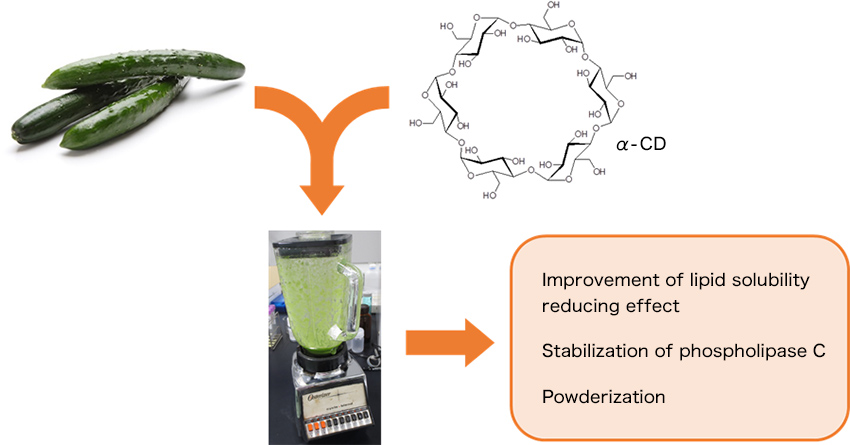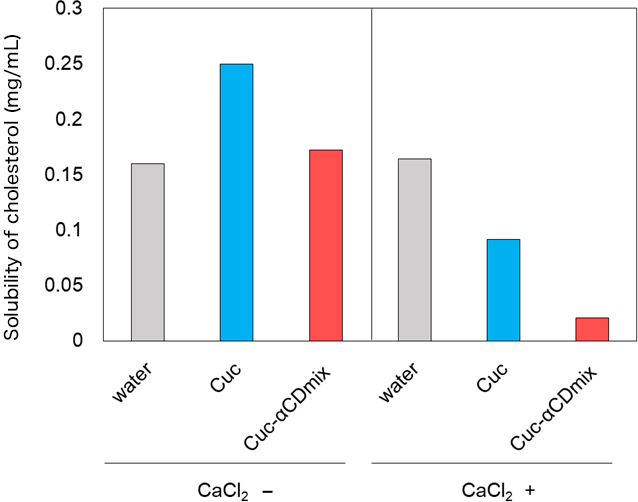No. 81 A study on improvement of lipid-lowering effect of cucumber by α-cyclodextrin

Overview
In recent years, it has been reported that Cucumber (Cucumis sativus L.) contains a large amount of phospholipase C having a lipid-lowering effect1). Phospholipase C is a kind of phospholipid degrading enzyme that suppresses lipid dissolution and absorption in the lumen of the small intestine. However, in order to exert a lipid-lowering effect, more than 100g of cucumber per day must be ingested having a problem that enzyme activity decreases due to heat treatment. On the other hand, we have previously revealed that α-cyclodextrin (α-CD) precipitates phospholipids contained in bile acid micelles in small intestinal fluid resulting in the reduction of cholesterol solubility2) and we have also found that α-CD has a stabilization effect of kiwi proteolytic enzyme3).
In this study, we investigated the effect of the combination of cucumber and α-CD on the cholesterol solubility-lowering effect on small intestinal fluid, stabilization of phospholipase C and powderization of cucumber by using α-CD.
Experiment
Cholesterol solubility test of a mixture of crushed cucumber (Cuc) and α-CD (Cuc-α-CD mix)
Commercially available cucumber and α-CD were added into deionized water. The mixture was pulverized and filtered to obtain a dispersed solution, which was used as a Cuc-α-CD mix. The cholesterol solubility test was carried out using an artificial intestinal fluid (FeSSIF) referring to the previous report2).
Stability evaluation of cucumber crude enzyme fraction (CucEnz) and its α-CD powder (CucEnz-α-CD)
The preparation of CucEnz and the phospholipase C activity test were performed with reference to the previously reported1). CucEnz was mixed with α-CD in deionized water and freeze-dried to obtain CucEnz-α-CD.
Powderization of cucumber by α-CD
Cucumber and α-CD were added in deionized water and pulverized with a blender, and the obtained paste was freeze-dried for the preparation of powder form.
Results and discussion
The results of the cholesterol solubility test are shown in fig. 1. Without addition of CaCl2, neither Cuc nor Cuc-α-CDmix showed cholesterol solubility-lowering effect. But when CaCl2 was added, both showed a solubility-lowering effect. Particularly Cuc-α-CDmix showed a remarkable effect. Since calcium ions affect the enzymatic activity of phospholipase C, it was suggested that phospholipase C in Cuc has the cholesterol solubility-lowering effect. Then, α-CD enhanced the phospholipase C activity.
Next, regarding to the stability of phospholipase C, the effect of α-CD was examined using a cucumber crude enzyme fraction. CucEnz and CucEnz-α-CD before heat treatment showed similar activities. But after heat treatment at 95℃, the activity of CucEnz was decreased. On the other hand, the enzymatic activity of CucEnz-α-CD was kept by the stabilization of phospholipase C by α-CD.
Finally, a powdering study with the solid content of cucumber at 10, 25, 50, 75 and 100% was conducted. When the solid contents of cucumber were higher than 75%, the powderization was not possible. But the contents were lower than 50%, the powderization was possible.

Summary
It was revealed that the use of α-CD improves the lipid solubility-lowering effect of cucumber, stabilizes phospholipase C activity, and powders cucumber. From this research, cucumber-α-CD powder is expected to be applied as a functional food material for the lipid-lowering effect.
References
1) D. Sugimori, et al., JP 2011-10608.
2) T. Furune, et al.,Beilstein .J.Org.Chem. 10, 2827 (2014).
3) Y. Asada, et al., 26th Cyclodextrin Symposium Abstracts, 148-149 (2009).
